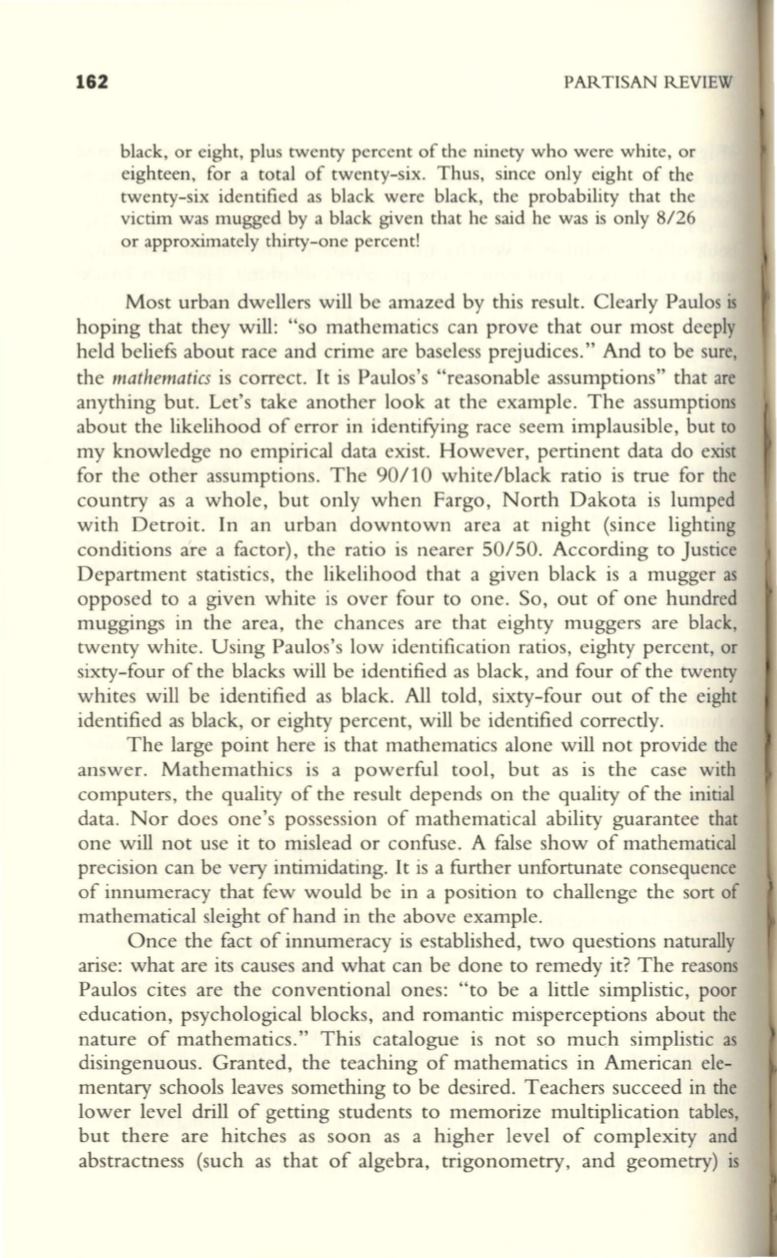
162
PARTISAN REVIEW
black, or eight, plus twenty percent of the ninety who were white, or
eighteen, for a total of twenty-six. Thus, since only eight of the
twenty-six identified as black were black, the probability that the
victim was mugged by a black given that he said he was is only 8/26
or approximately thirty-one percent!
Most urban dwellers will be amazed by this result. Clearly Paulos is
hoping that they will: "so mathematics can prove that our most deeply
held beliefs about race and crime are baseless prejudices." And to be sure,
the
mathematics
is correct.
It
is Paulos's "reasonable assumptions" that are
anything but. Let's take another look at the example. The assumptions
about the likelihood of error in identifying race seem implausible, but to
my knowledge no empirical data exist. However, pertinent data do exist
for the other assumptions. The 90/10 white/black ratio is true for the
country as a whole, but only when Fargo, North Dakota is lumped
with Detroit. In an urban downtown area at night (since lighting
conditions are a factor), the ratio is nearer 50/50. According to Justice
Department statistics, the likelihood that a given black is a mugger as
opposed to a given white is over four to one. So, out of one hundred
muggings in the area, the chances are that eighty muggers are black,
twenty white. Using Paulos's low identification ratios, eighty percent, or
sixty-four of the blacks will be identified as black, and four of the twenty
whites will be identified as black.
Ali
told, sixty-four out of the eight
identified as black, or eighty percent, will be identified correctly.
The large point here is that mathematics alone will not provide the
answer. Mathemathics is a powerful tool, but as is the case with
computers, the quality of the result depends on the quality of the initial
data. Nor does one's possession of mathematical ability guarantee that
one will not use it to mislead or confuse. A false show of mathematical
precision can be very intimidating. It is a further unfortunate consequence
of innumeracy that few would be in a position to challenge the sort of
mathematical sleight of hand in the above example.
Once the fact of innumeracy is established, two questions naturally
arise: what are its causes and what can be done to remedy it? The reasons
Paulos cites are the conventional ones: "to be a little simplistic, poor
education, psychological blocks, and romantic misperceptions about the
nature of mathematics ." This catalogue is not so much simplistic as
disingenuous. Granted, the teaching of mathematics in American ele–
mentary schools leaves something to be desired. Teachers succeed in the
lower level drill of getting students to memorize multiplication tables,
but there are hitches as soon as a higher level of complexity and
abstractness (such as that of algebra, trigonometry, and geometry) is


